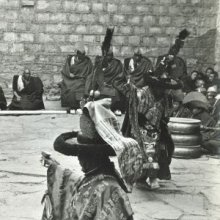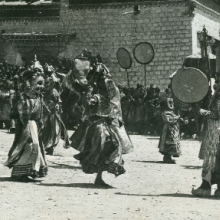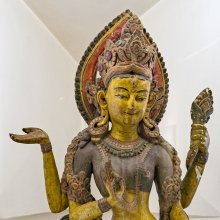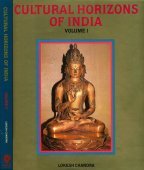Lhasa, Lhāsa: 2 definitions
Introduction:
Lhasa means something in Hinduism, Sanskrit, Jainism, Prakrit. If you want to know the exact meaning, history, etymology or English translation of this term then check out the descriptions on this page. Add your comment or reference to a book if you want to contribute to this summary article.
Images (photo gallery)
In Hinduism
Kavya (poetry)
Source: OpenEdition books: Vividhatīrthakalpaḥ (Kāvya)Lhāsa (ल्हास) in Prakrit refers to a name appearing in the canonical list of Mleccha peoples, as is mentioned in the Vividhatīrthakalpa by Jinaprabhasūri (13th century A.D.): an ancient text devoted to various Jaina holy places (tīrthas).—(Kirfel 1920 p. 226-7).

Kavya (काव्य, kavya) refers to Sanskrit poetry, a popular ancient Indian tradition of literature. There have been many Sanskrit poets over the ages, hailing from ancient India and beyond. This topic includes mahakavya, or ‘epic poetry’ and natya, or ‘dramatic poetry’.
Languages of India and abroad
Prakrit-English dictionary
Source: DDSA: Paia-sadda-mahannavo; a comprehensive Prakrit Hindi dictionaryLhasa (ल्हस) in the Prakrit language is related to the Sanskrit word: Sraṃs.
Prakrit is an ancient language closely associated with both Pali and Sanskrit. Jain literature is often composed in this language or sub-dialects, such as the Agamas and their commentaries which are written in Ardhamagadhi and Maharashtri Prakrit. The earliest extant texts can be dated to as early as the 4th century BCE although core portions might be older.
See also (Relevant definitions)
Starts with: Lhasana, Lhasava, Lhasavia.
Query error!
Full-text: Hlasa, Srams, Lakshanatika, Ü-tsang, Tibetan Buddhism, Samkshiptabhishekavidhi, Kham, Dalai Lama, Four opponent powers.
Relevant text
Search found 24 books and stories containing Lhasa, Lhāsa, Lhasas; (plurals include: Lhasas, Lhāsas, Lhasases). You can also click to the full overview containing English textual excerpts. Below are direct links for the most relevant articles:
Hindu Architecture in India and Abroad (by Prasanna Kumar Acharya)
Hindu Architecture in Tibet < [Chapter 8 - Hindu Architecture m Border Lands]
Hindu Architecture in Nepal < [Chapter 8 - Hindu Architecture m Border Lands]
The Way of the White Clouds (by Anāgarika Lāma Govinda)
Chapter 40 - Magic as Method and Practical Knowledge < [Part 3 - Death and Rebirth]
Chapter 33 - Interlude at dungkar gompa < [Part 3 - Death and Rebirth]
Kathasaritsagara (the Ocean of Story) (by Somadeva)
Chapter LXXXVII < [Book XII - Śaśāṅkavatī]
Bodhisattvacharyavatara (by Andreas Kretschmar)
Text Section 251 < [Khenpo Chöga’s Oral Explanations]
Interview With Khenpo Pema Sherab < [Introduction Text]
Life Story Of Dzongsar Khenpo Kunga Wangchuk < [Introduction Text]
Tibet (Myth, Religion and History) (by Tsewang Gyalpo Arya)
3. Kachem Kaholma [Tib: bKa' chems ka khol ma] < [Chapter 1 - Early Tibetan Origin Myth]
8. Tibetan Grammar; Sum cu pa and rTags 'jug < [Chapter 5 - Tibetan Language and Writing System]
1. King Srongtsan Gampo [Tib: Srong btsan sgam po] < [Chapter 4 - King Srongtsan Gampo and His Period]
Blue Annals (deb-ther sngon-po) (by George N. Roerich)
Chapter 16a - Lo ras pa (Gtsang pa rgya ras’ disciple) < [Book 8 - The famous Dakpo Kagyü (traditions)]
Chapter 13 - Staglungpa (xi): bkra shis dpal brtsegs < [Book 8 - The famous Dakpo Kagyü (traditions)]
Chapter 13 - Staglungpa (xvi): General Remarks on Monastic History < [Book 8 - The famous Dakpo Kagyü (traditions)]
Related products



